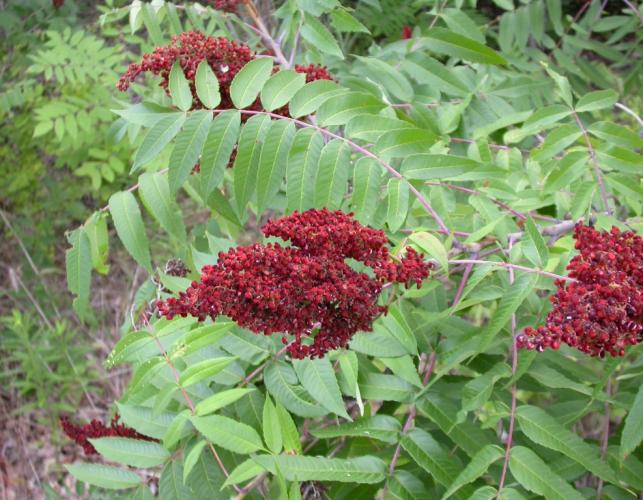I've been collecting sumac berries for years to make a lemonade-like beverage, and have since read about the medicinal properties of sumac, but somehow I only recently learned that these same fuzzy red berries are also the source of za-atar, the lemony middle eastern spice. How had this knowledge evaded me for so long?!
Identification
There are several species of sumac trees or shrubs in North America, and the berries can be used from all of these. The low woody plant known as Aromatic Sumac should not be used. And of course steer clear of poison sumac if that grows near you!
Poison sumac has a drooping cluster of whitish berries. AVOID THESE! ⇓

A hallmark feature of the edible sumacs is the red cone shaped cluster of small almost fuzzy berries, which is handy, as this is what you want to harvest to make za'atar.

For a comprehensive guide on winged sumac (Rhus copallinum), check out the Missouri Department of Conservation's fine site. Other common varieties of sumac from which the berries can also be collected include Staghorn Sumac (Rhus typhina), and Smooth Sumac (Rhus glabra). The Missouri Dept. of Conservatino has a great overall Sumac species overview, complete with lots of photos. Go MDC!
Other look-alike species include Elderberries and Tree of Heaven or Alianthus. Elderberries do make berries, but they ripen sooner, are dark purple to blackish, are in a flat plane of fruit, and are juicy. Tree of Heaven have similar flower clusters, but are high above reach and make a winged fruit, like a cluster of maple "airplanes".
Making Za'atar from Sumac Berries
When the berries start looking ripe, begin doing little taste tests. Put your tongue to the berry cluster. You want to encounter a strong lemony and sticky surface. When this occurs, the berry clusters are ready to harvest.
After picking out undesirable insects, de-stem the berries, and dry them in a dehydrator, the oven on the lowest setting, or in a bright sunny spot with low humidity.

Next, this sounds too good to be true, but simply place them in a blender. The inner seed core won't be ground up, but the fuzzy spice powder will get dislodged! Then simply sift the power into a bowl. From here, pour the powder into spice jars and proudly display them in your spice rack.
The za'atar is great in fish dishes and hummus. I also like to make a tea by combining the powdery spice with hot water, steeping, straining, and freezing in ice-cube trays. These make a great addition to gin-and-tonics and also in lieu of lemon juice when you want a sour punch!

